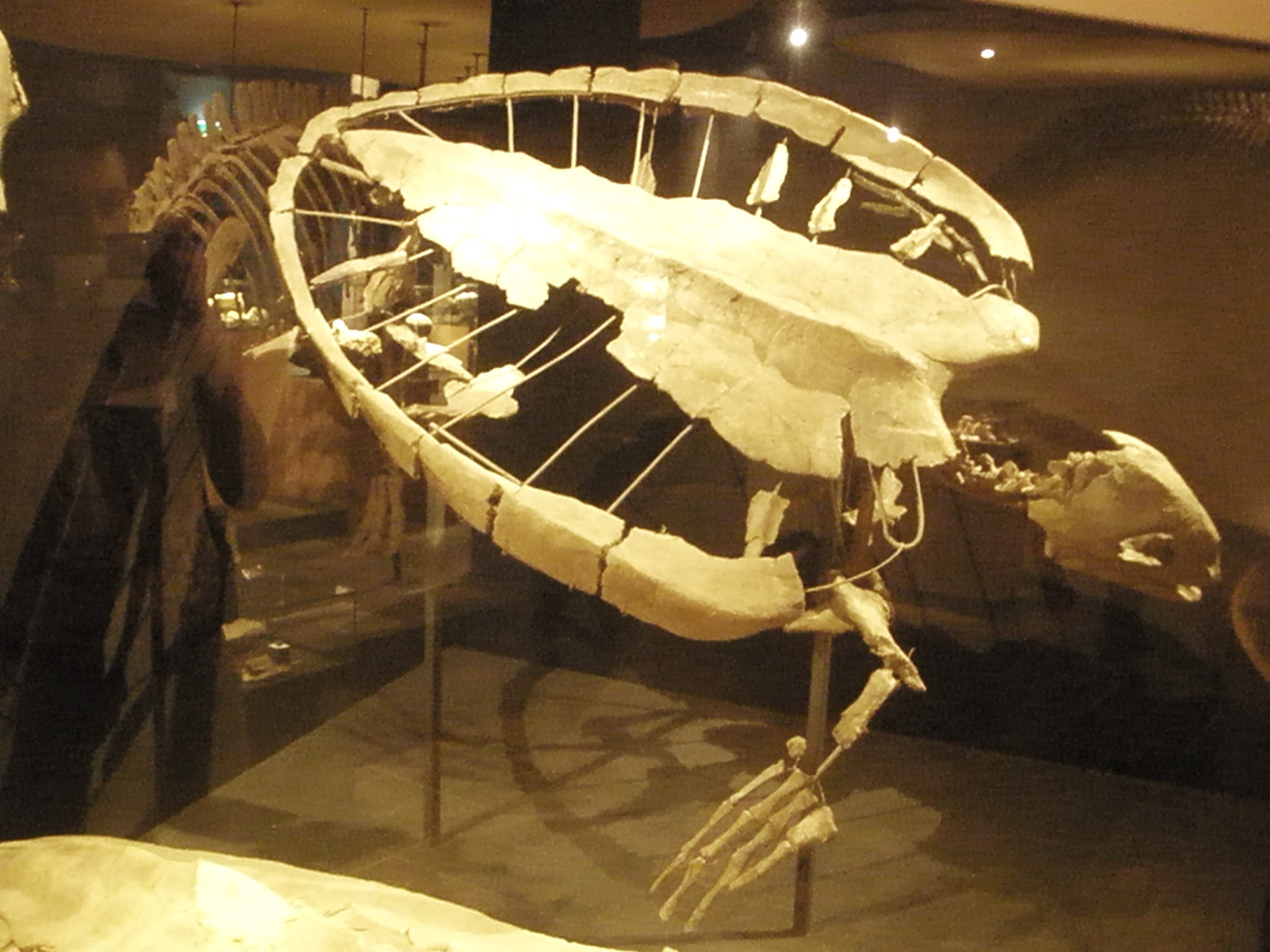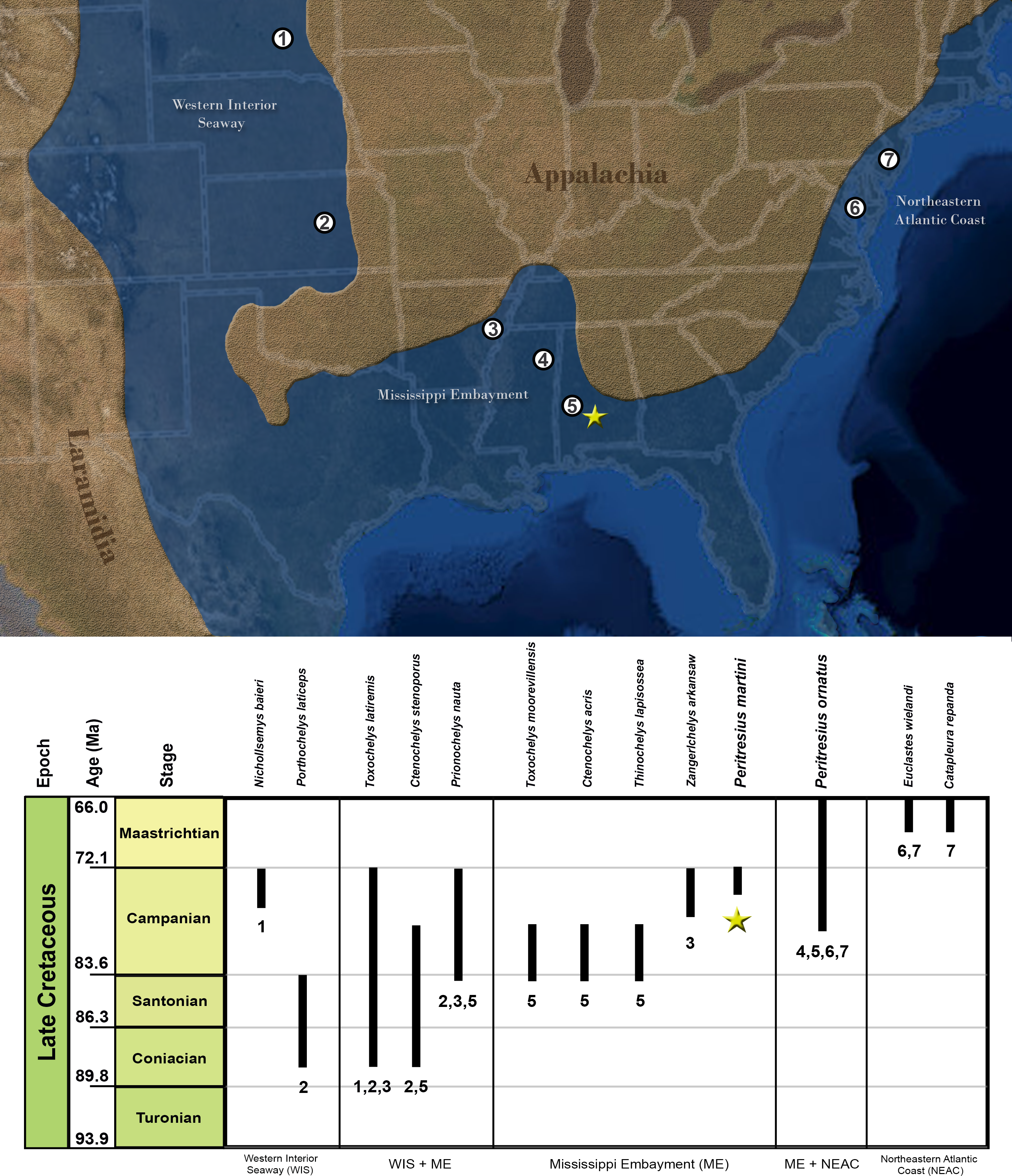|
Dermochelyoidae
Dermochelyidae is a family of turtles which has seven extinct genera and one extant genus, including the largest living sea turtles. Classification of known genera The following list of dermochelyid species was published by Hirayama and Tong in 2003, unless otherwise noted. * ''Arabemys crassiscutata'' * †''Eosphargis breineri'' * ''Mesodermochelys undulatus'' *Subfamily Dermochelyinae ** †''Cosmochelys'' ** ''Dermochelys coriacea'' – leatherback sea turtle ** †''Psephophorus ''Psephophorus'' is an extinct genus of sea turtle that lived from the Oligocene to the Pliocene. Its remains have been found in Europe, Africa, North America, and New Zealand. It was first named by Hermann von Meyer in 1847, and contains seve ...'' Phylogeny Evers et al. (2019): References Bibliography * External linksFamily Dermochelyidae (Leatherback turtles) from Turtles of the World by C.H. Ernst, R.G.M. Altenburg & R.W. Barbour {{Taxonbar, from=Q2738058 Taxa named by Leopo ... [...More Info...] [...Related Items...] OR: [Wikipedia] [Google] [Baidu] |
Late Cretaceous
The Late Cretaceous (100.5–66 Ma) is the younger of two epochs into which the Cretaceous Period is divided in the geologic time scale. Rock strata from this epoch form the Upper Cretaceous Series. The Cretaceous is named after ''creta'', the Latin word for the white limestone known as chalk. The chalk of northern France and the white cliffs of south-eastern England date from the Cretaceous Period. Climate During the Late Cretaceous, the climate was warmer than present, although throughout the period a cooling trend is evident. The tropics became restricted to equatorial regions and northern latitudes experienced markedly more seasonal climatic conditions. Geography Due to plate tectonics, the Americas were gradually moving westward, causing the Atlantic Ocean to expand. The Western Interior Seaway divided North America into eastern and western halves; Appalachia and Laramidia. India maintained a northward course towards Asia. In the Southern Hemisphere, Australia and Ant ... [...More Info...] [...Related Items...] OR: [Wikipedia] [Google] [Baidu] |
Toxochelys
''Toxochelys'' () is an extinct genus of marine turtle from the Late Cretaceous period. It is the most commonly found fossilized turtle species in the Smoky Hill Chalk, in western Kansas. Description ''Toxochelys'' was about 2 m (6 ft) in length. Two species in the genus are recognized, ''Toxochelys latiremis'' and ''Toxochelys moorevillensis''. Phylogenetic analysis shows that ''Toxochelys'' belong to an extinct lineage of turtles transitional between modern sea turtles Sea turtles (superfamily Chelonioidea), sometimes called marine turtles, are reptiles of the order Testudines and of the suborder Cryptodira. The seven existing species of sea turtles are the flatback, green, hawksbill, leatherback, loggerhead, ... and other turtles. ''Toxochelys bauri'' Williston, 1905, based on the skeleton YPM 1786, is a synonym of '' Ctenochelys stenoporus''.R. Zangerl. 1953. The vertebrate fauna of the Selma Formation of Alabama. Part IV. The turtles of the family Toxochelyid ... [...More Info...] [...Related Items...] OR: [Wikipedia] [Google] [Baidu] |
Cabindachelys
''Cabindachelys'' is a genus of extinct sea turtles. The only known species is ''Cabindachelys landanensis''. Fossils A partial skull of the ''Cabindachelys'' has been found in Cabinda, Angola, by Timothy S. Myers, Michael J. Polcyn, Octávio Mateus, Diana P. Vineyard, A. O. Gonçalves, Louis L. Jacobs. Habitat ''Cabindachelys'' lived in deep subtidal indents of the shores of Cabinda, Angola. Etymology The name of ''Cabindachelys'' is a mixture of Cabinda the place where it lived and the Greek name for turtle Turtles are an order of reptiles known as Testudines, characterized by a special shell developed mainly from their ribs. Modern turtles are divided into two major groups, the Pleurodira (side necked turtles) and Cryptodira (hidden necked tu .... Phylogeny References Chelonioidea Prehistoric turtle genera Paleocene turtles Fossil taxa described in 2017 {{paleo-turtle-stub ... [...More Info...] [...Related Items...] OR: [Wikipedia] [Google] [Baidu] |
Peritresius
''Peritresius'' is an extinct genus of sea turtle Sea turtles (superfamily Chelonioidea), sometimes called marine turtles, are reptiles of the order Testudines and of the suborder Cryptodira. The seven existing species of sea turtles are the flatback, green, hawksbill, leatherback, loggerhead, ... from the Late Cretaceous deposits in the US Eastern Seaboard. Taxonomy Two species are known, ''Peritresius ornatus'' Leidy, 1856 and ''P. martini'' Gentry, Parham, Ehret, and Ebersole, 2018, both from Campanian-Maastrichtian age deposits in New Jersey, Alabama, and Mississippi.Gentry AD, Parham JF, Ehret DJ, Ebersole JA (2018) A new species of Peritresius Leidy, 1856 (Testudines: Pan-Cheloniidae) from the Late Cretaceous (Campanian) of Alabama, USA, and the occurrence of the genus within the Mississippi Embayment of North America. PLoS ONE 13(4): e0195651. https://doi.org/10.1371/journal.pone.0195651 References Cheloniidae Cretaceous turtles Extinct animals of the United S ... [...More Info...] [...Related Items...] OR: [Wikipedia] [Google] [Baidu] |
Ctenochelys
''Ctenochelys'' is an extinct genus of marine turtle (Cryptodira, Pancheloniidae), which existed during the Cretaceous period, and lived in the shallow waters of the Western Interior Seaway. Its fossils have been found in the Ripley Formation and Mooreville Chalk of central Alabama, United States. It was first named by C.H. Sternberg in 1904, and contains two species, ''C. stenoporus'' and ''C. acris''. Species *''Ctenochelys stenoporus'' is the type species. It was originally thought to be a species of ''Toxochelys''; ''T. bauri'', until Sternberg declared it a separate genus. The two genera are similar in carapaces. *''Ctenochelys acris'' was first named by Zangerl in 1953 and is now thought to be one of the earliest ancestors of modern cheloniid Cheloniidae is a family of typically large marine turtles that are characterised by their common traits such as, having a flat streamlined wide and rounded shell and almost paddle-like flippers for their forelimbs. They are th ... [...More Info...] [...Related Items...] OR: [Wikipedia] [Google] [Baidu] |
Puppigerus
''Puppigerus'' is an extinct genus of sea turtle from the Eocene. It is known from finds in the United States, the United Kingdom, Belgium, Denmark, and Uzbekistan. Taxonomy ''Puppigerus'' was described by Edward Drinker Cope in 1870. As of 1997, ''P. camperi'' and ''P. crassicostata'' were considered the two valid species. ''P. camperi'' was later thought to be the sole species of the genus until the 2005 discovery of ''P. nessovi'' from Uzbekistan. Description Fossils show that ''Puppigerus'' was around long, and its weight has been estimated as being somewhere around . Although cheloniids such as ''Puppigerus'' first appeared during the Cretaceous, several traits of this genus give it more of a resemblance to modern cheloniids: its "huge" eyes pointed sideways rather than upward, unlike more primitive cheloniids, and its shell was completely ossified. The pygal (rearmost plate of the upper shell) also lacked the notch seen in earlier cheloniids. It was a herbivore, living ... [...More Info...] [...Related Items...] OR: [Wikipedia] [Google] [Baidu] |
Eochelone
''Eochelone'' is an extinct genus of sea turtle from the late Eocene. It was first named by Dollo in 1903. Its type species is ''E. brabantica''. References Professor Paul's Guide to Reptiles''Eochelone''in the Paleobiology Database The Paleobiology Database is an online resource for information on the distribution and classification of fossil animals, plants, and microorganisms. History The Paleobiology Database (PBDB) originated in the NCEAS-funded Phanerozoic Marine Pale ... * * Chelonioidea Eocene turtles Fossils of Denmark Prehistoric turtle genera Monotypic prehistoric reptile genera {{paleo-turtle-stub ... [...More Info...] [...Related Items...] OR: [Wikipedia] [Google] [Baidu] |
Procolpochelys
''Procolpochelys'' is an extinct genus of sea turtle from the Miocene of what is now Maryland, Virginia, and New Jersey. Its fossils have been found in the Calvert Formation. It was first named by Hay in 1908. References External links ''Procolpochelys''at the Paleobiology Database The Paleobiology Database is an online resource for information on the distribution and classification of fossil animals, plants, and microorganisms. History The Paleobiology Database (PBDB) originated in the NCEAS-funded Phanerozoic Marine Pale ... www.scistp.org Cryptodira Fossils of the United States Miocene turtles Prehistoric turtle genera Taxa named by Oliver Perry Hay Extinct turtles {{paleo-turtle-stub ... [...More Info...] [...Related Items...] OR: [Wikipedia] [Google] [Baidu] |
Argillochelys
''Argillochelys'' is an extinct genus of sea turtle from the middle to lower Eocene in what is now Britain. It was first named by Lydekker in 1889. A species, ''A. africana'', was found in Morocco, and described in 2008 by Tong & Hirayama. References External links ''Argillochelys''at the Paleobiology Database The Paleobiology Database is an online resource for information on the distribution and classification of fossil animals, plants, and microorganisms. History The Paleobiology Database (PBDB) originated in the NCEAS-funded Phanerozoic Marine Pale ... www.ppne.co.uk Eocene turtles Chelonioidea Eocene reptiles of Europe Eocene reptiles of Africa Prehistoric turtle genera Taxa named by Richard Lydekker Fossil taxa described in 1889 {{paleo-turtle-stub ... [...More Info...] [...Related Items...] OR: [Wikipedia] [Google] [Baidu] |
Cheloniidae
Cheloniidae is a family of typically large marine turtles that are characterised by their common traits such as, having a flat streamlined wide and rounded shell and almost paddle-like flippers for their forelimbs. They are the only sea turtles to have stronger front limbs than back limbs. The six species that make up this family are: the green sea turtle, loggerhead sea turtle, olive ridley sea turtle, hawksbill sea turtle, flatback sea turtle and the Kemp's ridley sea turtle. Morphology In contrast to their earth-bound relatives, tortoises, sea turtles do not have the ability to retract their heads into their shells. Their plastron, which is the bony plate making up the underside of a turtle or tortoise's shell, is comparably more reduced from other turtle species and is connected to the top part of the shell by ligaments without a hinge separating the pectoral and abdominal plates of the plastron. Sizes among the seven species of sea turtles range from 71 to 213 cm; for e ... [...More Info...] [...Related Items...] OR: [Wikipedia] [Google] [Baidu] |
Allopleuron
''Allopleuron'' is a genus of extinct sea turtle, which measured long in life. The type species is ''Allopleuron hofmanni''. It is a basal member of the clade Pancheloniidae, closely related to ''Protosphargis''. Similar to ''Protosphargis'', it was characterized by shell reduction. Fossil history ''Allopleuron'' lived from the Early Cretaceous (Cenomanian age, 94.3 Ma) to the Oligocene (Rupelian age, 28.4 Ma), therefore surviving the Cretaceous-Paleogene extinction event. Fossils have been found from Germany, the Netherlands, Kazakhstan and the United States. Life history ''Allopleuron'' was believed to have used the Laurasian-Holarctic The Holarctic realm is a biogeographic realm that comprises the majority of habitats found throughout the continents in the Northern Hemisphere. It corresponds to the floristic Boreal Kingdom. It includes both the Nearctic zoogeographical region ... southern continental shelf as a breeding area. The modern day location of the breeding ... [...More Info...] [...Related Items...] OR: [Wikipedia] [Google] [Baidu] |
Nichollsemys
''Nichollsemys'' is a genus of extinct sea turtles. The only known species is ''Nichollsemys baieri''. Taxonomy Fossils of the ''Nichollsemys'' have been found in Alberta, Canada, by Donald Brinkman. The fossils found are all skulls. The name of ''Nichollsemys'' is a tribute to Elizabeth Nicholls, a paleontologist from Canada who studied marine reptiles from the Triassic period. She had previously done work with Brinkman when they found the ichthyosaur genus Pattinatator. Evolution Description The full length of the ''Nichollsemys'' is unknown, but Brinkman made a chart of the length of some parts of the specimen. The length from the basioccipital to the premaxilla measures 11.4 cm, the width of all the quadrates measures 9.8 cm, the depth at level of the quadrates measures 7.1 cm, the intraorbital width measures 2 cm, and the length measures 3.6 cm. The cranium has many things in common with that of Toxochelys ''Toxochelys'' () is an extinct genus of marine ... [...More Info...] [...Related Items...] OR: [Wikipedia] [Google] [Baidu] |




